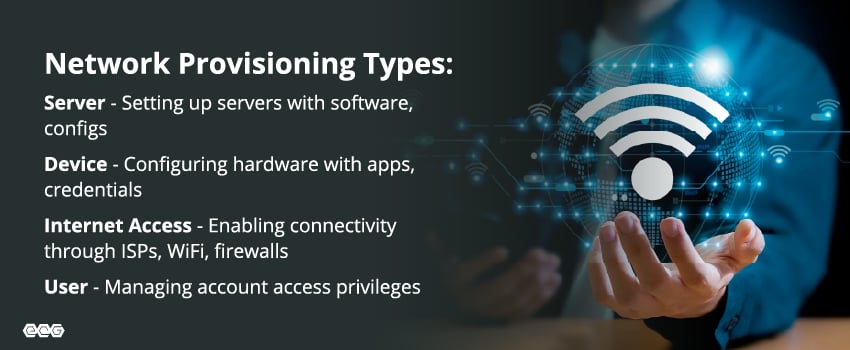Network provisioning is a critical process for businesses to ensure authorized users, devices, and servers can access their network. It concerns both connectivity and security, including setting up Wi-Fi users, uploading software, assigning IP addresses, and configuring firewalls. Properly provisioning your network enables your employees to work more efficiently while improving your organization’s cyber security posture.
In this blog, we'll explore the importance of network provisioning for your business and how automated network provisioning solutions can transform your operations.
What Are the Benefits of Network Provisioning?
When done correctly, network provisioning provides enhanced security, as only approved users and devices can access your company’s sensitive systems and data. This reduces the risks associated with digital systems and mitigates potential cyber threats. Other network provisioning benefits include:
Streamlined Workflows
Proper network provisioning can also lead to optimized employee workflows. By ensuring staff have access to the appropriate resources for their role, they can quickly perform duties without obstacles or frustration.
Improved Compliance
Staying compliant with industry regulations around security, accessibility, and more is easier with a well-provisioned network. The controls implemented during provisioning can help your IT team create a digital environment that meets and maintains regulatory compliance requirements.
What Are the Challenges of Network Provisioning?
Manual network provisioning has become increasingly challenging for businesses of all sizes. The rapid growth of devices, remote employees, and network activity can be time-consuming to manage without automation, making it difficult to scale and resulting in errors that affect performance.
.jpg?width=850&height=350&name=ecg_blog_networkprovisioning_inline1%20(1).jpg)
What Is Automated Network Provisioning?
Automated network provisioning uses software to handle many provisioning processes instantly, freeing up network administrators to focus on other tasks and cutting down on human errors that could cause inefficiencies and security issues.
A single IT professional can manage the entire network with automated provisioning tools. The automated software monitors your network as it grows, applies the necessary policies, assigns IP addresses, and configures IP-based devices. Automated tools also provide detailed reports and logs, simplifying network audits and making regulatory compliance easier to achieve.
With automated network provisioning, your IT team can dedicate more resources to innovation and serving customers rather than basic IT support. Plus, automating this once-manual process gives your business a more secure, error-free network primed for growth.
Types of Network Provisioning
When provisioning a business network, a few main areas need configuration for users and systems to function optimally. Traditionally, IT administrators have handled much of this manual setup work. However, modern automated tools can accelerate many provisioning processes.
Server Provisioning
For a network to function, a server must first be provisioned with the right data and software. Manual server provisioning involves installing operating systems, drivers, and enterprise software, setting IPs, configuring virtualization platforms, and auditing the system.
Automated tools simplify many of these tedious IT tasks. Cloud providers often include server provisioning wizards, and automation platforms can self-configure devices based on predefined settings.
Device Provisioning
Before rolling out hardware like computers, tablets, and printers to the workforce, the equipment needs proper configuration and security protocols installed. IT departments have typically handled steps like assigning credentials, apps, and profiles.
Automation instantly sets up these devices, handling enrollment and profile assignments to streamline the process across an enterprise.

Internet-Access Provisioning
Enabling network access for on-site employees and remote staff involves tasks like contracting with ISPs, purchasing networking hardware, configuring wireless access points, installing cabling, and setting up firewalls and security protocols.
Traditionally, network architects handle these duties manually as they build out and update office internet capabilities. Automation can simplify much of this process through solutions ranging from network mapping to AI-powered network configuration.
User Provisioning
Tasks like onboarding new hires, transferring employees, and offboarding those who leave involve provisioning user accounts and access privileges. This often involves coordinating with HR while manually managing identities and permissions, which can be time-intensive.
Automation simplifies user lifecycle management by automatically creating, modifying, or deactivating accounts according to specific triggers, like hiring events. Self-service portals also enable users to request access themselves.
Speed Up Your Network Provisioning With ECG’s Alpaca
Network provisioning is the backbone of modern business operations, but manually performing this important task takes time and effort that your IT team could use elsewhere. Luckily, automated network provisioning tools like ECG's Alpaca can help streamline your provisioning process and stay ahead of the competition.
Alpaca's bulk provisioning feature lets service providers activate BroadWorks networks in just 30 minutes – not the several hours associated with manual service activation. Alpaca enables you to reuse provisioning templates for faster system rebuilds and pre-validates all imported data to prevent errors, ensuring your network provisioning runs seamlessly.
Ready to learn more about how Alpaca can transform your BroadWorks service delivery? Get in touch with the ECG team today.


